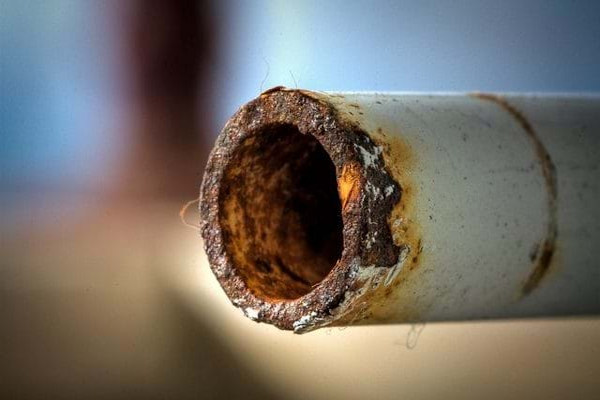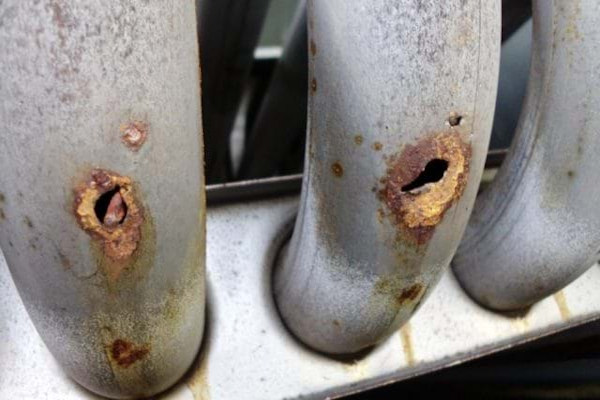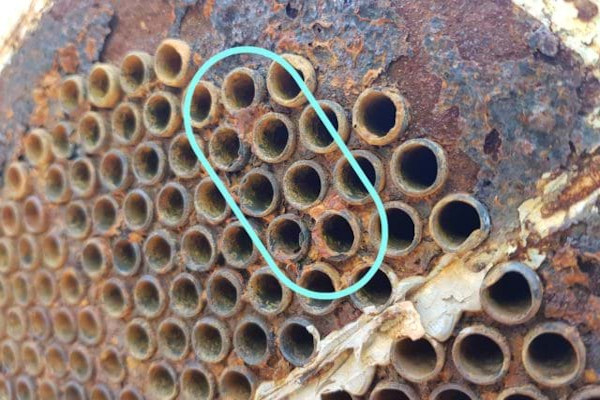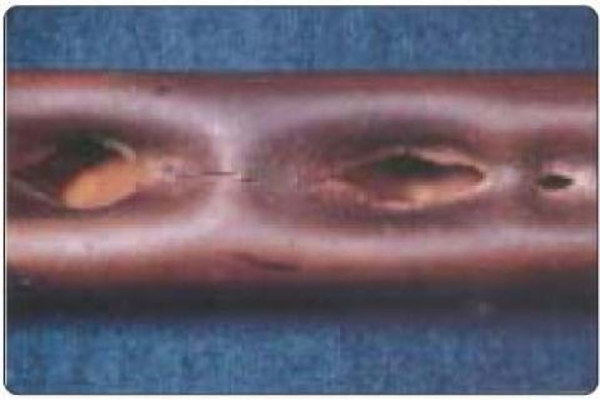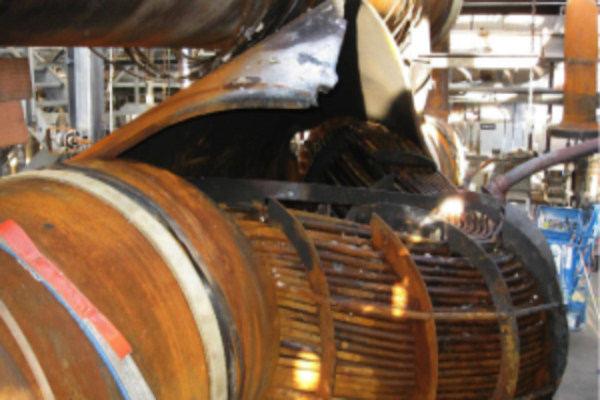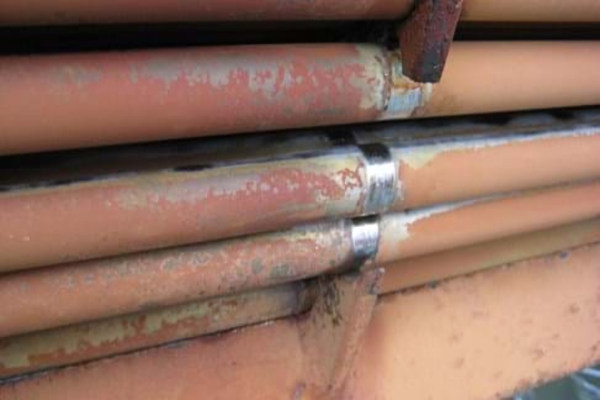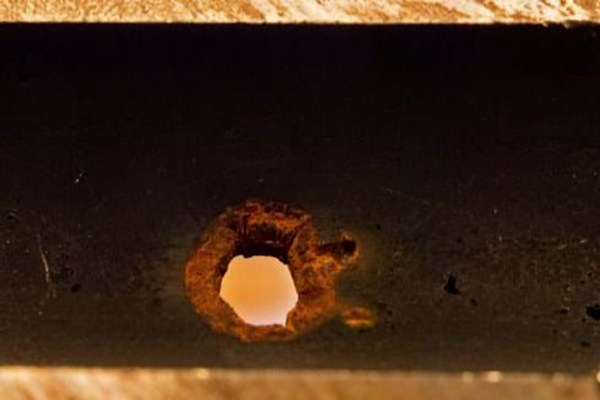Six Causes of Heat Exchanger Tube Failure
1. Tube Corrosion
The biggest threat to shell and tube heat exchangers that use carbon steel tubes is oxidation (corrosion) of the heat transfer surface of its tubes.
The reaction between oxygen (O2) and iron (Fe2, Fe3) is the most commonly observed form of corrosion. This reaction yields a building layer of iron oxide (Fe2O3) on carbon steel tubes which results in decreasing thermal permeation and eventually the deterioration of the tubes. This problem is difficult to combat and is often only detected when tubes become so corroded their thermal performance levels decrease, the fluid flow is significantly reduced or the tubes are perforated and leak.
2. Tube Erosion
Erosion of tubes is the physical wearing of the metal by fluids. Fluids with high levels of total dissolved solids – such as silica, silt or sea water containing salt, sand and marine life – catalyze the erosion of tubes both internally and at the leading edges of the inlet tubes.
Although all tubes are subject to erosion over time, the weakest points for tubes are generally the U bend (if any) and the leading edge of the inlet tubes.
U-bend Erosion
Tube-side fluid velocity in excess of manufacturers’ recommendations can lead to erosion damage along the internal face of the returning outer bend of the U-bend. The change in direction of flow at this point introduces resistance to its flow causing the force of the fluid, and any particulates in it, to concentrate against the far wall of the tube, constantly eroding the tube at this point.
Inlet Tube-end Erosion
Significant erosion of the tubes can also be found at the leading ends of the inlet tubes, where the tubes are connected through the tube sheets and face the full force of the incoming fluid. At this point the division of fluid flow from a single stream into many smaller streams results in turbulence and extremely-high localised velocities.
3. Steam or Water Hammer
Steam or water hammer is a powerful force and can cause the rupture or collapse of either the shell or the tubes of a heat exchanger. Hammer generally occurs where there has been a surge in pressure commonly caused by a sudden interruption in cooling water flow, the rapid vaporization of stagnant water or pump malfunction. The phenomenon can be observed in feed-water heaters where high steam pressures increase the chances of hammer.
Hammer can often be heard, but only rarely will it damage the shell. Tubes, being weaker than the shell, are the more likely victims of hammer, however damage to tubes will only be detected on internal inspection or when leaks become apparent.
4. Thermal Fatigue
Heat exchanger tubes are vulnerable to tears and cracks due to accumulated stresses related to constant thermal cycling or high temperature differentials. Thermal fatigue occurs when extreme temperature differences between the shell and tubes result in tube flexing.
Another result of high temperature differentials is the physical thermal expansion and contraction of tubes along their length, which may eventually compromise the integrity of a tube’s connection to the tube sheet, causing leaks.
The threat of thermal fatigue is almost impossible to diagnose until a failure has occurred.
5. Vibration/Resonance
Vibration and resonance, from whatever source and whether induced externally and internally, can impose powerful forces on heat exchanger tubes and, once vibration or resonance is commenced it can increase in intensity to a point where tubes rupture and fail or lose their seal with the tube-sheet and leak.
Baffles provide a vital support for the tubes in a shell and tube heat exchanger and direct the flow of the shell-side fluid to assist in thermal energy exchange. Heat exchanger tubes are normally either welded or tightly roller-expanded into their tube sheets to ensure the join does not leak. Both the sites of a tube’s contact with baffles and tube sheets are points of weakness.
Excessive tube-side velocities of fluids may result in a tube vibrating or resonating at high frequency, causing abrasion between it and the baffle edge. This can cause either the tube to rupture or the tube’s bond with the tube-sheet to fail.
Equipment or machinery, to which a shell and tube heat exchanger is attached, may also transfer its external vibration to heat exchanger tubes and cause damage or failure.
6. Pitting of Tubes
Chemically-induced corrosion can result in the pitting of heat exchanger tubes to the point where pinholes form and the tube fails and leaks.
Pitting results from the electrochemical potential set up by differences inside and outside of, what is commonly referred to as, a concentration cell. The oxygen-rich environment in this cell acts as an anode and the metal surface as a cathode, resulting in the metal surface being slowly pitted by the chemical reaction.
A concentrated electrochemical gradient of oxygen (O2) and carbon dioxide (CO2) is frequently the cause of tube wall pitting, as is the presence of excess chemical compounds such as chlorides and sulphates often found in inadequately treated cooling water.
Where to now?
If we can learn anything from the number of risks presented, it is that shell and tube heat exchangers:
- Demand and deserve respect and require monitoring and maintenance;
- Are a vital part of many processes which may be compromised if the heat exchanger fails.
You should consider what will happen:
- If the heat exchanger fails – will production/performance be significantly reduced, or will there be a complete shutdown?
- If one fluid leaks into to the other – will the fluids, product and the environment be contaminated?
- If a spare heat exchanger is not readily available – will a potentially lengthy shut down:
- to carry out repairs;
- to source a replacement; or
- to manufacture a custom-built unit
adversely affect your production; your business; your career?

